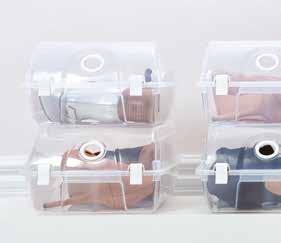
4 minute read
How to DIY
With many of us spending more time at home, why not try some DIY jobs that may be bigger than you would usually take on?
The great thing about doing it yourself, is the pride you get after finishing the job.
Advertisement
In this guide, we are going to show you how to do two of the largest DIY jobs: one inside and one outside. But remember, always consult a professional if the task at hand goes beyond your capabilities or involves electrics or gas.
Tiling any room, whether it be a bathroom or kitchen, may seem like a daunting task. However, by following our easy to follow guide, you can have it done in no time… TILING A KITCHEN OR BATHROOM
l Wall tiles l Filler l Tile adhesive l Tile spacers l Grout l Multi-purpose cloths l Tile trim MATERIALS NEEDED
l Ruler l Tape measure l Trowel l Tile cutter l Grout float l Spirit level TOOLS

Step 1 – Fill any holes in the wall with filler, smooth and leave to dry. Step 2 – Starting from the edge of the wall, and at the lowest row, use tile adhesive to start attaching tiles. Step 3 – Between each tile place a spacer to ensure the gaps between are equal. Step 4 – As you reach the end you may need to cut a tile. Use an electric tile cutter with plenty of water and make sure you measure carefully and cut slowly. Step 5 – Move onto the next row up, again using spacers, and slide any tile trim into place at the end. Make sure to follow any decorative design you are using. Step 6 – If you come to any electrical sockets, measure carefully and cut the tile to shape before applying the tile to the wall.
Step 7 – Leave tiles to dry in situ for 24 hours. Step 8 – Once dry, apply a liberal coating of grout across the tiles, before then using multi-purpose cloths with warm water to wipe away excess grout from the tiles. Step 9 – Thoroughly wash down and polish the tiles to remove any dust and remaining grout and leave to dry.

Remember, with any DIY job, try to get the best tools possible, including the best materials you can afford. Equally important, keep your tools clean after every use and remember to have fun!


MATERIALS
Cement Sand Aggregate Water Patio slabs Patio grout
LAYING A PATIO With the warmer weather here, why not add another area to your garden in the shape of a perfect patio you have laid yourself. Usually a job you would get a professional in for, laying a patio isn’t actually as difficult as you might expect.
TOOLS
Shovel Cement mixer (you can hire these) Trowel Wacker plate Bucket Long spirit Level Wooden dowling Rubber mallet Large grout float Outdoor brush
Step 1 – Mark out the patio area after doing measurements on a piece of paper. Dig down 150mm for the entire patio trying to create as flat an area as possible. Step 2 – Lay builders aggregate until it covers the entire base area of the patio. Step 3 – Use a Wacker Plate to level down and create a tight base level for laying the slabs. Step 4 – Lay a corner slab without any mortar to check the level of the patio as this will be your keystone. If the height is perfect move onto mixing your mortar.
Step 5 – Connect your cement mixer safely to your electrics. Use 1 part of cement to 5 parts of sand and slowly add water as it mixes until you reach the desired consistency. Step 6 – Using a shovel, pour mortar mix directly onto the base where the first slab is going to go. Lay the slab and using a spirit level, check it is even. Add or remove aggregate and mortar as necessary until it is level. This is your keystone. Step 7 – Follow this process again, adding mortar and laying the next stone next to the keystone. Use the long spirit level to ensure the second slab is the same level as the keystone. If it is a very small amount out, use a rubber mallet to knock it into place. Step 8 – Complete laying patio slabs in rows, following the previous slab, which should be level with the keystone, using the long spirit level. Step 9 – Clean your tools to ensure the cement doesn’t dry on them. Step 10 – Leave to dry for 48-hours. Once dry, apply patio grout using the large grout float. Wipe over the edges using a cloth. Once dry, use an outdoor brush to remove any excess dust.









